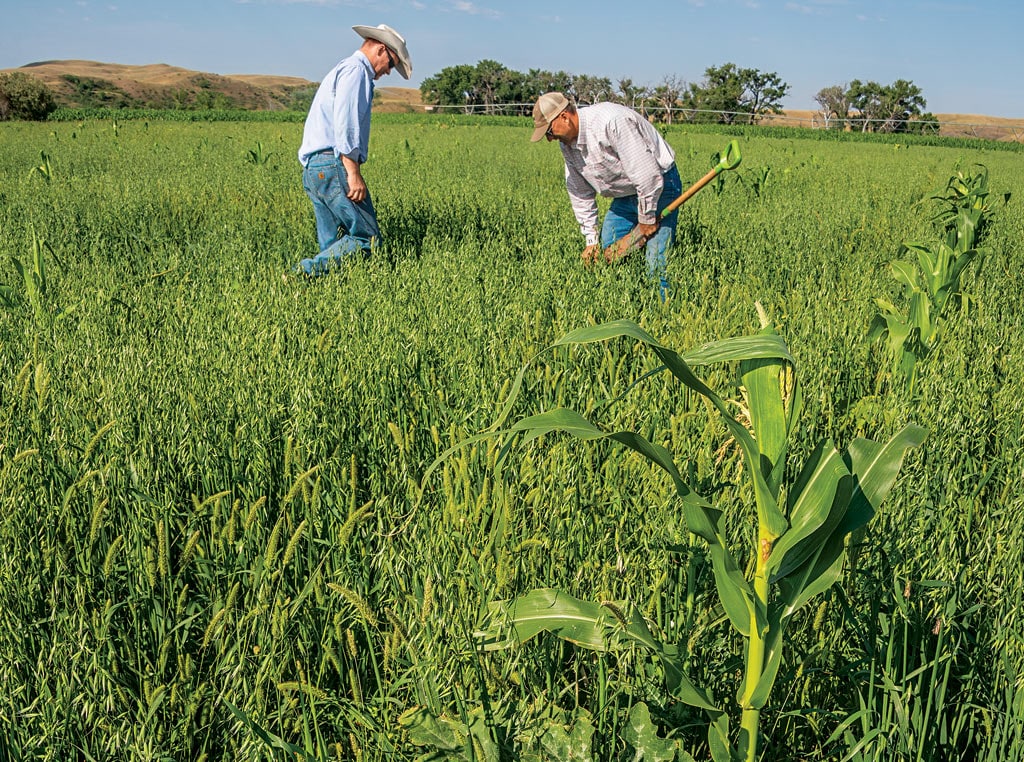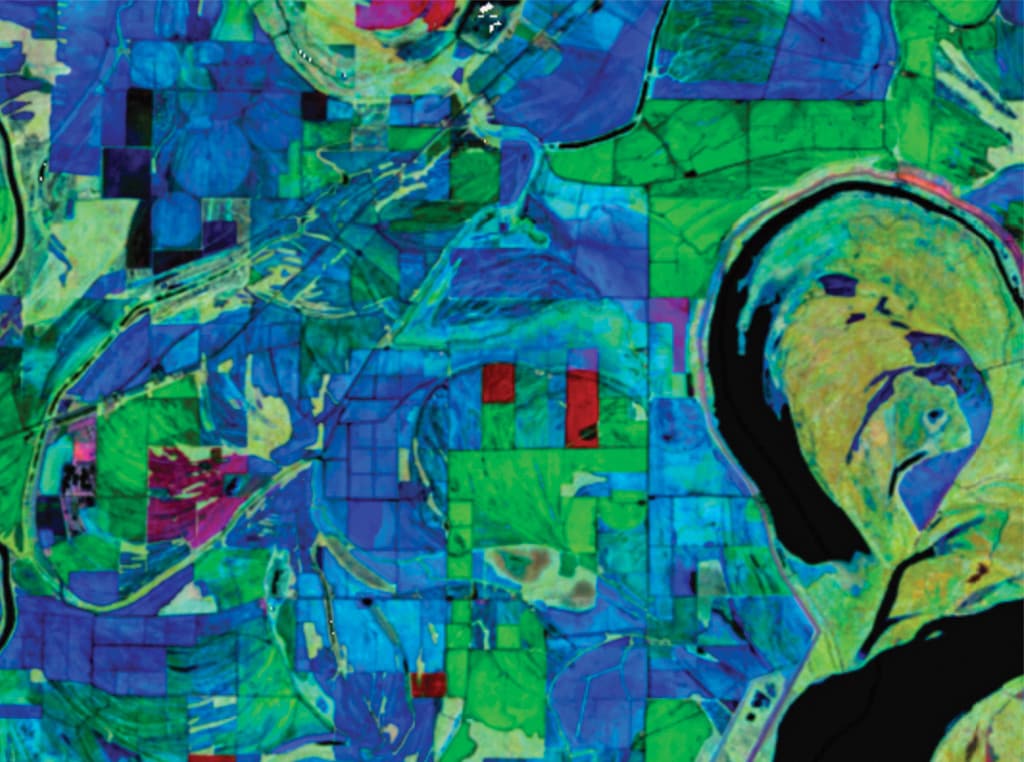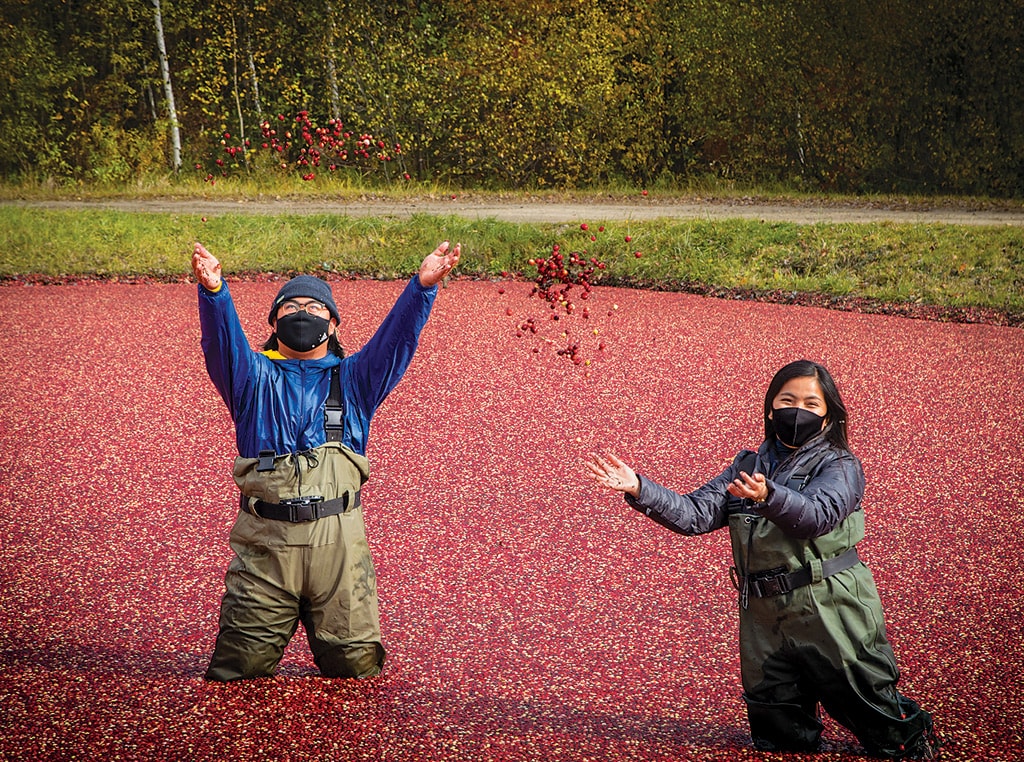
Mentor Shawn Freeland (R) shows neighbor Roy Hendrickson his pumpkin patch where a “Three Sisters” combination of corn, soybean and pumpkins were seeded into an oats and clover cover crop.
Agriculture, Education March 01, 2021
In It Together
Mentorship highlights the brotherhood of farming.
A tour for one. Despite a long to-do list, Caputa, South Dakota, farmer and rancher Shawn Freeland took a hot August morning to show his neighbor, Roy Hendrickson, his latest soil health improvement strategies. This day they focused on cover crops and pastured hogs pulverizing branches in an area that flooded. Serving on the board of directors for the South Dakota Soil Health Coalition (SDSHC) and volunteering as one of more than 150 soil health mentors, Freeland is used to setting aside his own work for a few minutes—or a few hours—to help a fellow farmer.
“I want everyone to do well, it doesn’t make sense to hoard the information,” Freeland says of sharing the knowledge he did a lot of footwork to gather. “I know how hard it was for me to get answers. If someone calls me and has questions, I’m more than willing to share my experiences.”
So are many of his progressive peers. The SDSHC was formed by South Dakota farmers and ranchers in 2015 to educate about and encourage improving soil health. Already an organization of peers, it was a natural fit to form the SDSHC Mentor Network in 2017.
Answering the call. SDSHC sees soil health as the keystone to sustainable and regenerative agricultural production. Their web site, SDSoilHealthCoalition.org provides an array of technical and educational material as does their newsletter. They host intensive soil health schools and an annual soil health conference. The mentor network, though, is a favorite resource and will soon become a more nimble tool. SDSHC is developing a grant-funded app to streamline contact.
“We heard over and over that producers needed quicker answers,” says Cindy Zenk, SDSHC coordinator. When standing in a field, wrench in hand, or poised to purchase seed for the year, producers often need help immediately. The app will allow questions to be asked directly through instant messaging or posed to a chat group specific to the category.
Each mentor is categorized by region and areas of specialty, such as grazing, cover crops or no-till. Before, producers would have to hunt for their book listing the mentors or reach out to Zenk to match with a mentor suited to their farm and situation.
“The app will put the information in the palm of their hand and give them a connection from the field they may not have had before,” Zenk said.
In order for this to work, though, mentors must pick up the phone or answer the messenger ping. Fortunately, they do.
“Farmers and ranchers of South Dakota wholeheartedly want each other to be successful and are willing to help and share what they’ve learned,” Zenk says.
This is proven out by the sheer number of volunteers willing to publish their contact information for all to see. There are mentors in every county of the state with most boasting multiple mentors.
As like minds group together, the network is further able to identify and meet needs. For example, the SDSHC created the South Dakota Grazing Exchange to match livestock owners needing forage with those who have pasture, cover crops or crop residue to graze.
The idea is catching, with other states showing interest in the unique and successful mentor program, Zenk says.
To the point. Freeland struggled to find information specific to his situation. He attended every field tour he heard of no matter how far the drive. He called NRCS and extension resources. He attended schools. All provided great knowledge, but when it came to his specific questions, the answer never quite fit.
“I wanted to graze pivots. I made so many calls and attended many events. Even at a grazing school I couldn’t get an answer. Finally I made a connection and now that’s all I do,” Freeland says.
What took him years to work out, his neighbor was easily able to put into practice by following his example.
“I haven’t gone anywhere. I only utilize Shawn because he already has the vast knowledge and he’s doing it right across the road,” Hendrickson says. In just two years, he’s already seeing his soil health improve dramatically. Which makes Freeland just as happy as it does Hendrickson.
“I can’t save the world on just my place, but if I can show somebody else how to improve their soil health and help them get there faster, then all our kids have something to come back to,” Freeland says.
Read More

Agriculture, Ag Tech
Ag Data Is Beautiful
Digital sattellite data paints farm masterpieces.

Agriculture, Specialty/Niche
Year-round Tourism
Muskoka farm develops innovative ways to incorporate four-season tourism attractions.
